Assessment of Influence Mechanisms of Built Environment on Street Vitality Using Multisource Spatial Data: A Case Study in Qingdao, China
Abstract
1. Introduction
2. Study Area, Data, and Methods
2.1. Study Area
2.2. Study Data
2.2.1. Open Street Map (OSM)
2.2.2. Points of Interest (POI)
2.2.3. Baidu Heat Map Data
2.2.4. Meituan Store Rating Data
2.2.5. Building Profile Data
2.3. Methods
2.3.1. FD-CR Model
2.3.2. Measure of Street Vitality
2.3.3. Measurement of Street Built Environment
2.3.4. K-Means Clustering
2.3.5. Getis–Ord Gi* Hotspot Index
2.3.6. Multiscale Geographically Weighted Regression Model
3. Results
3.1. Spatial Characteristics of Street Vitality in the Main Urban Area of Qingdao City
3.2. Spatial Distribution of Various Types of Dynamic Areas
- Category I—high cultural vitality, highest social vitality, and highest economic vitality, with economically oriented streets;
- Category II—highest cultural vitality, high social vitality, and medium economic vitality, with culturally oriented streets;
- Category III—medium cultural vitality, medium social vitality, and low economic vitality, with socially oriented streets;
- Category IV—lowest cultural vitality, lowest social vitality, and lowest economic vitality, with all-around deficient streets.
3.3. Influence of Built Environment on Street Vitality
4. Discussion
4.1. Analysis of the Spatial Characteristics of Street Vitality in the Main Urban Area of Qingdao City
4.2. Analysis of the Influence of Built Environment on Street Vitality
4.3. Innovation
4.4. Limitations
5. Conclusions
- The overall development of street comprehensive vitality in the main urban area of Qingdao City is uneven. Streets with high vitality are mainly located in the downtown area, with the core of the business district decreasing outward in a group-like manner.
- The historical influence of street development leads to significant differences in various types of vitality in different streets. Vitality is higher in all categories in the southern streets and weaker in all categories in the western and eastern streets. The vital poles in the southern part of the main urban area are already developed, and there are smaller vital poles in the west and east that are being nurtured and need to continue to improve their attractiveness. The distribution of social vitality is relatively balanced, with economic vitality gathered in the streets where commerce, leisure, and entertainment are concentrated, while cultural vitality is gathered in the city center and the convention center of Laoshan.
- The degree of functional mix in a street affects its vitality. Mixed-function streets are more vital than single-function streets, avoiding the need for people to have their other requirements met on a larger scale.
- The improvement of the built environment is the key to the enhancement of street vitality. Built environment factors with significant spatial heterogeneity inhibit or enhance street vitality in Qingdao City’s main urban areas to different degrees, and measures to enhance vitality need to be taken according to local conditions.
Author Contributions
Funding
Institutional Review Board Statement
Informed Consent Statement
Data Availability Statement
Acknowledgments
Conflicts of Interest
References
- Turok, I.; McGranahan, G. Urbanization and economic growth: The arguments and evidence for Africa and Asia. Environ. Urban. 2013, 25, 465–482. [Google Scholar] [CrossRef]
- Halepoto, I.A.; Sahito, A.A.; Uqaili, M.A.; Chowdhry, B.S.; Riaz, T. Multi-criteria assessment of smart city transformation based on SWOT analysis. In Proceedings of the 2015 5th National Symposium on Information Technology: Towards New Smart World (NSITNSW), Riyadh, Saudi Arabia, 17–19 February 2015; pp. 1–6. [Google Scholar]
- Zhang, L.; Wang, Y.H.; Guo, Y.N. A Research on the Coordination of Land Urbanization and Economic Urbanization in China. East China Econ. Manag. 2016, 30, 111–117. [Google Scholar]
- Zhang, R.T.; Jiao, H.F. A review on new urbanization research in China. World Reg. Stud. 2016, 25, 59–66. [Google Scholar]
- Montgomery, M.R. The urban transformation of the developing world. Science 2008, 319, 761–764. [Google Scholar] [CrossRef]
- Jiang, D. On the Vitality of Urban Form; Southeast University Press: Nanjing, China, 2007. [Google Scholar]
- Li, Q.; Cui, C.; Liu, F.; Wu, Q.; Run, Y.; Han, Z. Multidimensional urban vitality on streets: Spatial patterns and influence factor identification using multisource urban data. ISPRS Int. J. Geo-Inf. 2021, 11, 2. [Google Scholar] [CrossRef]
- Jacobs, J. The Death and Life of Great American Cities; Random House: New York, NY, USA, 1961. [Google Scholar]
- Lynch, K. Good City Form; MIT Press: Cambridge, MA, USA, 1984. [Google Scholar]
- Maas, P.R. Towards a theory of urban vitality. Ph.D. Thesis, University of British Columbia, Vancouver, BC, Canada, 1984. [Google Scholar]
- Calthorpe, P. The Next American Metropolis: Ecology, Community, and the American Dream; Princeton Architectural Press: Princeton, NJ, USA, 1993. [Google Scholar]
- Mouratidis, K.; Poortinga, W. Built environment, urban vitality and social cohesion: Do vibrant neighborhoods foster strong communities? Landsc. Urban Plan. 2020, 204, 103951. [Google Scholar] [CrossRef]
- Gehl, J.; Kaefer, L.J.; Reigstad, S. Close encounters with buildings. Urban Des. Int. 2006, 11, 29–47. [Google Scholar] [CrossRef]
- Marcus, L. Spatial capital. J. Space Syntax 2010, 1, 30–40. [Google Scholar]
- Racine, F. Developments in urban design practice in Montreal: A morphological perspective. Urban Morphol. 2016, 20, 122–137. [Google Scholar] [CrossRef]
- Moffatt, S.; Kohler, N. Conceptualizing the built environment as a social–ecological system. Build. Res. Inf. 2008, 36, 248–268. [Google Scholar] [CrossRef]
- Zhou, H.; He, S.; Cai, Y.; Wang, M.; Su, S. Social inequalities in neighborhood visual walkability: Using street view imagery and deep learning technologies to facilitate healthy city planning. Sustain. Cities Soc. 2019, 50, 101605. [Google Scholar] [CrossRef]
- Fu, R.; Zhang, X.; Yang, D.; Cai, T.; Zhang, Y. The relationship between urban vibrancy and built environment: An empirical study from an emerging city in an Arid Region. Int. J. Environ. Res. Public Health 2021, 18, 525. [Google Scholar] [CrossRef] [PubMed]
- Jiang, Y.; Han, Y.; Liu, M.; Ye, Y. Street vitality and built environment features: A data-informed approach from fourteen Chinese cities. Sustain. Cities Soc. 2022, 79, 103724. [Google Scholar] [CrossRef]
- Long, Y.; Huang, C.C. Does block size matter? The impact of urban design on economic vitality for Chinese cities. Environ. Plan. B-Urban 2019, 46, 406–422. [Google Scholar] [CrossRef]
- Oliveira, V. Morpho: A methodology for assessing urban form. Urban Morphol. 2013, 17, 21–33. [Google Scholar] [CrossRef]
- Sung, H.G.; Go, D.H.; Choi, C.G. Evidence of Jacobs’s street life in the great Seoul city: Identifying the association of physical environment with walking activity on streets. Cities 2013, 35, 164–173. [Google Scholar] [CrossRef]
- Jalaladdini, S.; Oktay, D. Urban public spaces and vitality: A socio-spatial analysis in the streets of Cypriot towns. Procedia Soc. Behav. Sci. 2012, 35, 664–674. [Google Scholar] [CrossRef]
- Zarin, S.Z.; Niroomand, M.; Heidari, A.A. Physical and social aspects of vitality case study: Traditional street and modern street in Tehran. Procedia Soc. Behav. Sci. 2015, 170, 659–668. [Google Scholar] [CrossRef]
- Candia, J.; González, M.C.; Wang, P.; Schoenharl, T.; Madey, G.; Barabási, A.-L. Uncovering individual and collective human dynamics from mobile phone records. J. Phys. A Math. Theor. 2008, 41, 224015. [Google Scholar] [CrossRef]
- Griffin, M.; Nordstrom, B.W.; Scholes, J.; Joncas, K.; Gordon, P.; Krivenko, E.; Haynes, W.; Higdon, R.; Stewart, E.; Kolker, N. A case study: Analyzing city vitality with four pillars of activity—L live, work, shop, and play. Big Data 2016, 4, 60–66. [Google Scholar] [CrossRef]
- Shi, L.; Chi, G.; Liu, X.; Liu, Y. Human mobility patterns in different communities: A mobile phone data-based social network approach. Ann. GIS 2015, 21, 15–26. [Google Scholar] [CrossRef]
- Sung, H.; Lee, S. Residential built environment and walking activity: Empirical evidence of Jane Jacobs’ urban vitality. Res. Part D Transp. Environ. 2015, 41, 318–329. [Google Scholar] [CrossRef]
- Wu, W.; Niu, X.; Li, M. Influence of built environment on street vitality: A case study of West Nanjing Road in Shanghai based on mobile location data. Sustainability 2021, 13, 1840. [Google Scholar] [CrossRef]
- Liu, W. Spatial Impact of the Built Environment on Street Vitality: A Case Study of the Tianhe District, Guangzhou. Front. Environ. Sci. 2022, 10, 966562. [Google Scholar]
- Li, Y.; Yabuki, N.; Fukuda, T. Exploring the association between street built environment and street vitality using deep learning methods. Sustain. Cities Soc. 2022, 79, 103656. [Google Scholar] [CrossRef]
- Liu, C.; Lu, J.; Fu, W.; Zhou, Z. Second-hand housing batch evaluation model of zhengzhou city based on big data and MGWR model. J. Intell. Fuzzy Syst. 2022, 42, 4221–4240. [Google Scholar] [CrossRef]
- Tu, J. Spatially varying relationships between land use and water quality across an urbanization gradient explored by geographically weighted regression. Appl. Geogr. 2011, 31, 376–392. [Google Scholar] [CrossRef]
- Fotheringham, A.S.; Yang, W.; Kang, W. Multiscale geographically weighted regression (MGWR). Ann. Am. Assoc. Geogr. 2017, 107, 1247–1265. [Google Scholar] [CrossRef]
- Zhang, W. Planning: Qingdao made clear the 12 strategic tasks of the “Fourteenth Five Year Plan”. Toward. World 2021, 16, 8–9. [Google Scholar]
- Liu, X.; Long, Y. Automated identification and characterization of parcels with OpenStreetMap and points of interest. Environ. Plan. B-Plan. Des. 2016, 43, 341–360. [Google Scholar] [CrossRef]
- National Standard (Mandatory) of the People’s Republic of China: Code for Classification of Urban Land Use and Planning Standards of Development Land; China Planning Press: Beijing, China, 2012.
- Shi, P.; Xiao, Y.; Zhan, Q. A study on spatial and temporal aggregation patterns of urban population in Wuhan City based on Baidu heat map and POI data. Int. Rev. Spat. Plan. Sustain. Dev. 2020, 8, 101–121. [Google Scholar] [CrossRef] [PubMed]
- Gu, C.; Wang, Y.; Shao, Y.; Gu, J. Research on administrative divisions based on functional areas analysis: A case of Shaoxing metropolitan area. Acta Geogr. Sin. 2015, 70, 1187–1201. [Google Scholar]
- Xia, C.; Yeh, A.G.O.; Zhang, A. Analyzing spatial relationships between urban land use intensity and urban vitality at street block level: A case study of five Chinese megacities. Landsc. Urban Plan. 2020, 193, 103669. [Google Scholar] [CrossRef]
- Wu, W.; Ma, Z.; Guo, J.; Niu, X.; Zhao, K. Evaluating the Effects of Built Environment on Street Vitality at the City Level: An Empirical Research Based on Spatial Panel Durbin Model. Int. J. Environ. Res. Public Health 2022, 19, 1664. [Google Scholar] [CrossRef]
- Tzeng, G.H.; Huang, J.J. Multiple Attribute Decision Making: Methods and Applications; CRC Press: Boca Raton, FL, USA, 2011. [Google Scholar]
- Soofi, E.S.; Retzer, J.J. Adjustment of importance weights in multiattribute value models by minimum discrimination information. Eur. J. Oper. Res. 1992, 60, 99–108. [Google Scholar] [CrossRef]
- Cervero, R.; Arrington, G.B. Vehicle trip reduction impacts of transit-oriented housing. J. Public Transp. 2008, 11, 1–17. [Google Scholar] [CrossRef]
- Ewing, R.; Tian, G.; Goates, J.P.; Zhang, M.; Greenwald, M.J.; Joyce, A.; Kircher, J.; Greene, W. Varying influences of the built environment on household travel in 15 diverse regions of the United States. Urban Stud. 2015, 52, 2330–2348. [Google Scholar] [CrossRef]
- Guo, X.; Chen, H.; Yang, X. An evaluation of street dynamic vitality and its influential factors based on multi-source big data. ISPRS Int. J. Geo-Inf. 2021, 10, 143. [Google Scholar] [CrossRef]
- Ord, J.K.; Getis, A. Local spatial autocorrelation statistics: Distributional issues and an application. Geog. Anal. 1995, 27, 286–306. [Google Scholar] [CrossRef]
- Brunsdon, C.; Fotheringham, A.S.; Charlton, M. Some notes on parametric significance tests for geographically weighted regression. J. Reg. Sci. 1999, 39, 497–524. [Google Scholar] [CrossRef]
- Oshan, T.M.; Li, Z.; Kang, W.; Wolf, L.J.; Fotheringham, A.S. MGWR: A python implementation of multiscale geographically weighted regression for investigating process spatial heterogeneity and scale. ISPRS Int. J. Geo-Inf. 2019, 8, 269. [Google Scholar] [CrossRef]
- Wang, Z.; Ma, D.; Sun, D.; Zhang, J. Identification and analysis of urban functional area in Hangzhou based on OSM and POI data. PLoS ONE 2021, 16, e0251988. [Google Scholar] [CrossRef] [PubMed]
- Zeng, C.; Song, Y.; He, Q.; Shen, F. Spatially explicit assessment on urban vitality: Case studies in Chicago and Wuhan. Sustain. Cities Soc. 2018, 40, 296–306. [Google Scholar] [CrossRef]
- Burton, E.; Jenks, M.; Williams, K. The Compact City: A Sustainable Urban Form? Routledge: London, UK, 2003. [Google Scholar]
- Wu, C.; Ren, F.; Hu, W.; Du, Q. Multiscale geographically and temporally weighted regression: Exploring the spatiotemporal determinants of housing prices. Int. J. Geog. Inf. Sci. 2019, 33, 489–511. [Google Scholar] [CrossRef]
- Lao, X.; Gu, H. Unveiling various spatial patterns of determinants of hukou transfer intentions in China: A multi-scale geographically weighted regression approach. Growth Chang. 2020, 51, 1860–1876. [Google Scholar] [CrossRef]
- Shabrina, Z.; Buyuklieva, B.; Ng, M.K.M. Short-term rental platform in the urban tourism context: A geographically weighted regression (GWR) and a multiscale GWR (MGWR) approaches. Geog. Anal. 2021, 53, 686–707. [Google Scholar] [CrossRef]
- Chen, Y.; Zhu, M.; Zhou, Q.; Qiao, Y. Research on spatiotemporal differentiation and influence mechanism of urban resilience in China based on MGWR model. Int. J. Environ. Res. Public Health 2021, 18, 1056. [Google Scholar] [CrossRef] [PubMed]
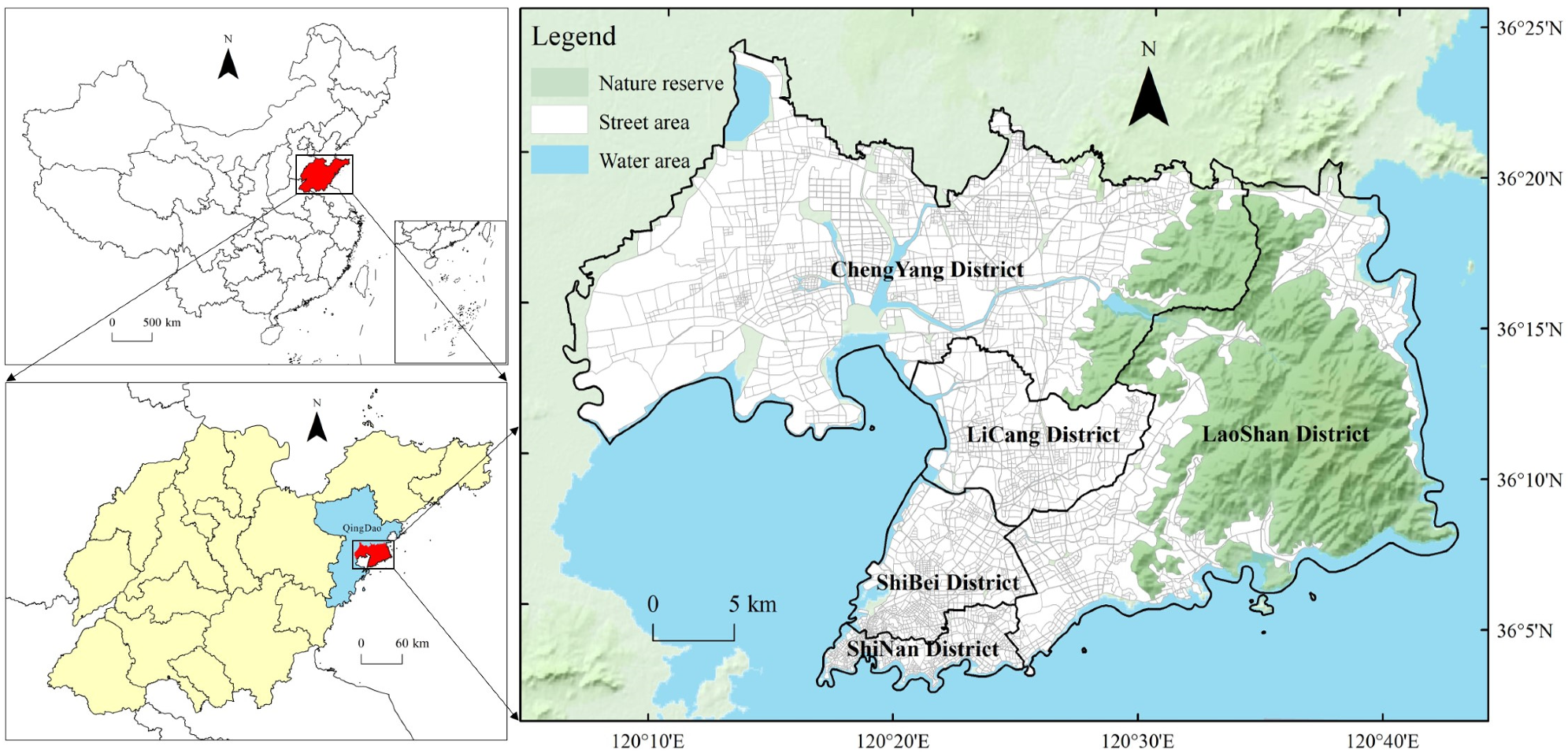



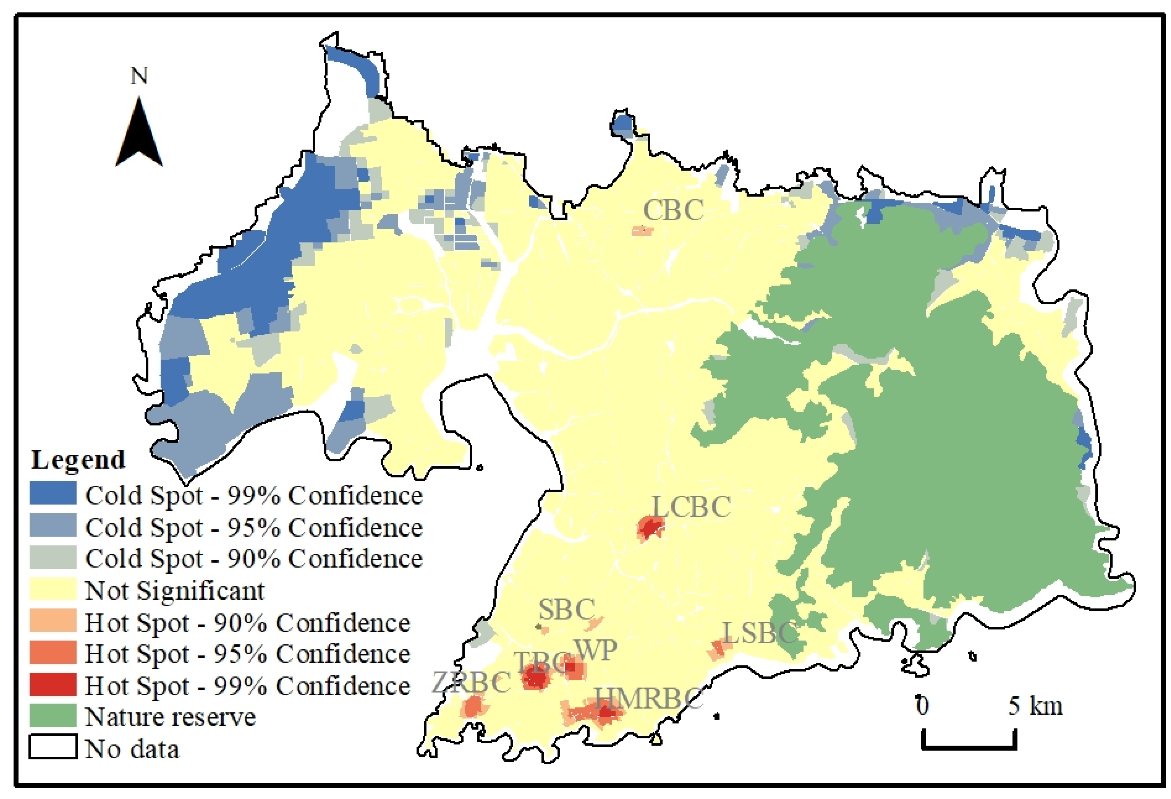
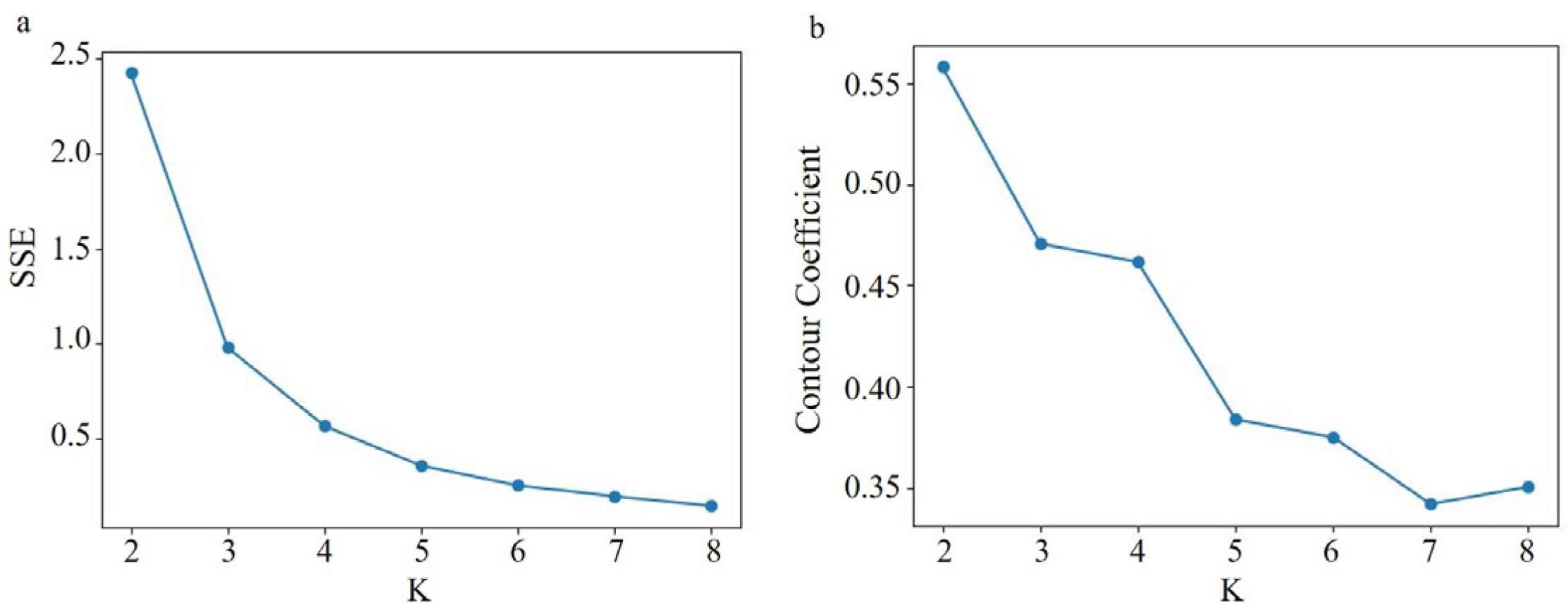
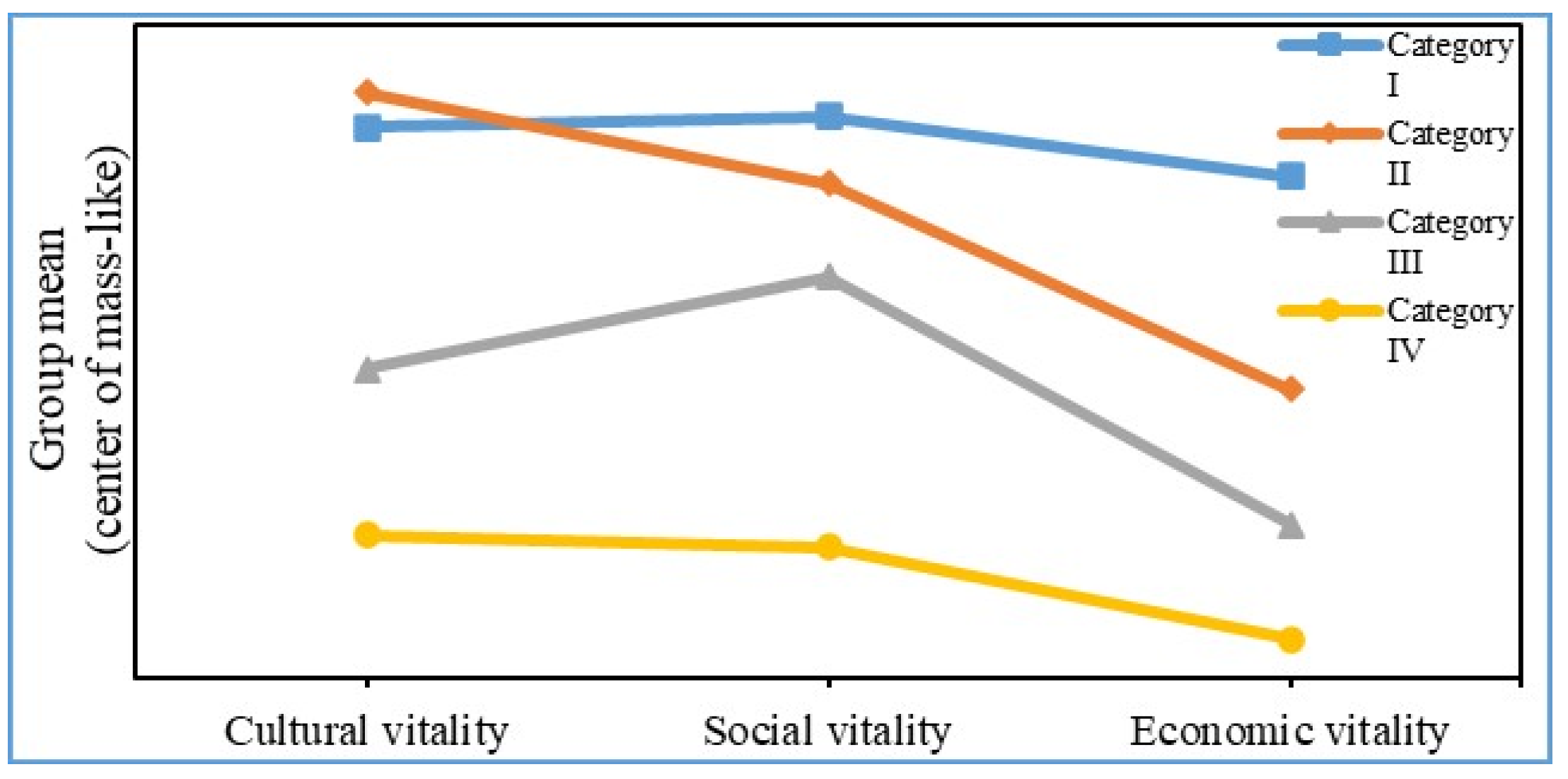
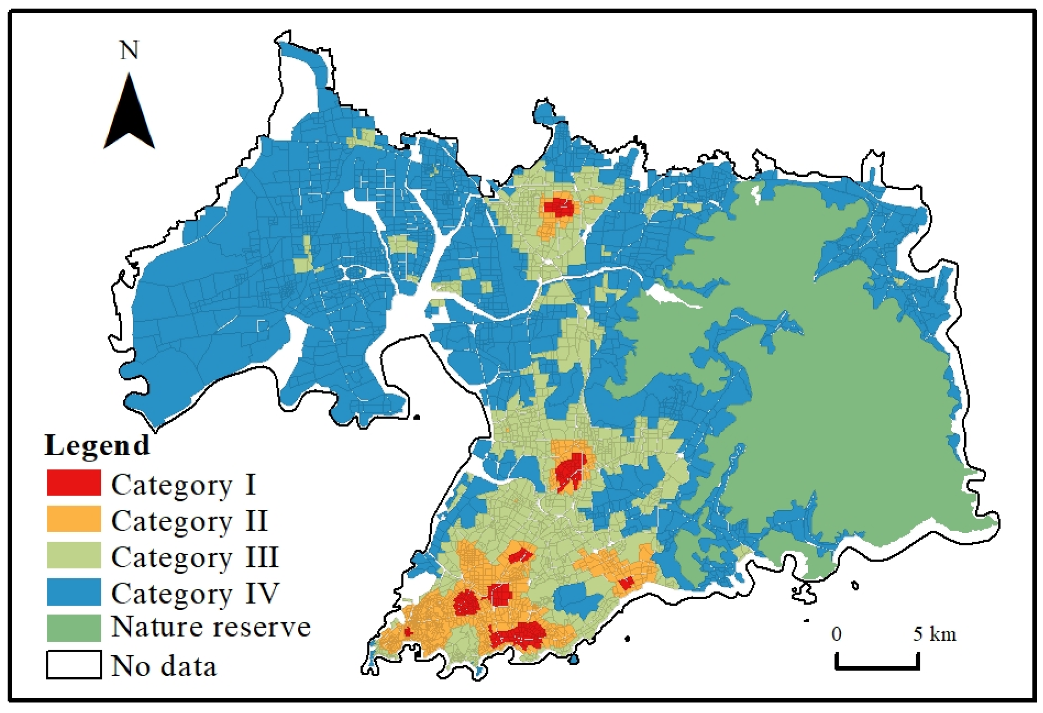

| Data Type | Data Name | Data Source | Year | Link |
|---|---|---|---|---|
| Basic geographic data | China map vector data | National basic geographic information center | 2021 | “http://www.ngcc.cn/ (accessed on 11 November 2021)” |
| Road network data | Open Street Map official website | 2021 | “https://www.openstreetmap.org/ (accessed on 7 December 2021)” | |
| Web open-source data | POI data | Gaode map crawler | 2022 | “https://ditu.amap.com/ (accessed on 18 January 2022)” |
| Baidu heat map data | Baidu map crawler | 2022 | “https://map.baidu.com/ (accessed on 10 April 2022)” | |
| Meituan store rating data | Meituan web crawler | 2022 | “https://qd.meituan.com/ (accessed on 19 February 2022)” | |
| Building profile data | Gaode map crawler | 2021 | “https://ditu.amap.com/ (accessed on 28 December 2021)” |
| First-Class Classification | Secondary Classification | Tertiary Classification |
|---|---|---|
| Residential land | Residential area, business housing-related areas | Villas, residential communities, community centers, etc. |
| Commercial land | Shopping services, catering services, accommodation services, leisure and entertainment, financial and insurance services | Supermarkets, hotels, restaurants, shopping centers, cinemas, banks, etc. |
| Industrial land | Companies, industrial and mining plants | Companies, factories, technology parks, industrial parks, etc. |
| Public service land | Government agencies, medical care, public facilities, etc. | Government agencies, social organizations, hospitals, emergency centers, railway stations, airports, docks, public facilities, etc. |
| Scientific, educational and cultural land. Green space and square land | Higher-education institutions, vocational institutions, secondary schools, elementary schools, science and education sites, etc. Tourist attractions, parks, and squares | Universities, high schools, elementary schools, kindergartens, vocational colleges, museums, libraries, etc. Scenic spots, zoos, botanical gardens, parks, squares, etc. |
| Nomenclature | Parameter |
|---|---|
| i | Number of POI categories |
| Fi | Frequency density of POI category i |
| ni | Number of POI category i in the street units |
| Ni | Total number of POI categories i |
| Ci | Proportion of POI category i functional type |
| αj | Weights obtained by the Criteria Importance Through Intercriteria Correlation (CRITIC) method for the j-th indicator |
| βj | Weight obtained by the entropy weighting method for the j-th indicator. |
| Wj | Combined weight of the j-th indicator |
| εi | Model regression residual |
| ym | Response variable |
| xmn | Covariate |
| βbwn | n-th local regression coefficient with MGWR bandwidth bw |
| (um,vm) | Spatial geographic location of the sample points |
| Dimensionality | Detection Index | Description |
|---|---|---|
| Density | POI density (pieces/km2) | Reflects the density of various functional POIs in the street |
| Floor area ratio (%) | Reflects the intensity of street development | |
| Building density (%) | Reflects the vacancy rate and building density of the street | |
| Design | Compactness (%) | Reflects the efficiency of street space form |
| Greening rate (%) | Reflects the environmental quality of the street | |
| Street area (m2) | Street unit area | |
| Density of public service facilities (pieces/km2) | Reflects the livability of the street | |
| Diversity | Mixing degree | Reflects the mixing degree of different types of POI and land use diversity |
| Distance to transit | Public transportation accessibility (pieces/km2) | Reflects the accessibility of the street |
| Destination accessibility | Distance from the business circle (km) | Reflects the extent to which the street vitality is influenced by the business circle |
| Distance from the subway station (m) | Reflects street subway accessibility | |
| Distance from the bus stop (m) | Reflects street transit accessibility |
| Model | RSS | AICc | R2 | Adjusted R2 | Bandwidth |
|---|---|---|---|---|---|
| GWR | 33.881 | −2505.299 | 0.99 | 0.985 | 74 |
| MGWR | 25.654 | −3826.325 | 0.992 | 0.989 | (44,554) |
| Variable | Mean | Standard Deviation | Min | Median | Max |
|---|---|---|---|---|---|
| Intercept | −1.912 | 0.836 | −3.391 | −1.767 | −0.599 |
| POI density | 0.034 | 0.028 | −0.022 | 0.039 | 0.107 |
| Compactness | 0.011 | 0.014 | −0.02 | 0.016 | 0.036 |
| Mixing degree | 0.009 | 0.051 | −0.245 | 0.01 | 0.28 |
| Greening rate | −0.032 | 0.059 | −0.26 | −0.026 | 0.253 |
| Floor area ratio | 0.024 | 0.24 | −1.133 | 0.045 | 0.301 |
| Building density | −0.017 | 0.054 | −0.095 | −0.029 | 0.214 |
| Street area | −0.253 | 0.279 | −1.352 | −0.192 | 0.33 |
| Density of public service facilities | 0.076 | 0.129 | −0.351 | 0.063 | 0.552 |
| Distance from the business circle | −2.687 | 2.272 | −5.522 | −2.977 | 2.472 |
| Distance from the subway station | 0.038 | 0.496 | −1.419 | 0.079 | 1.069 |
| Distance from the bus stop | −0.015 | 0.092 | −0.431 | −0.009 | 0.372 |
| Public transportation accessibility | 0.174 | 0.281 | −0.654 | 0.175 | 0.965 |
Disclaimer/Publisher’s Note: The statements, opinions and data contained in all publications are solely those of the individual author(s) and contributor(s) and not of MDPI and/or the editor(s). MDPI and/or the editor(s) disclaim responsibility for any injury to people or property resulting from any ideas, methods, instructions or products referred to in the content. |
© 2023 by the authors. Licensee MDPI, Basel, Switzerland. This article is an open access article distributed under the terms and conditions of the Creative Commons Attribution (CC BY) license (https://creativecommons.org/licenses/by/4.0/).
Share and Cite
Li, M.; Pan, J. Assessment of Influence Mechanisms of Built Environment on Street Vitality Using Multisource Spatial Data: A Case Study in Qingdao, China. Sustainability 2023, 15, 1518. https://doi.org/10.3390/su15021518
Li M, Pan J. Assessment of Influence Mechanisms of Built Environment on Street Vitality Using Multisource Spatial Data: A Case Study in Qingdao, China. Sustainability. 2023; 15(2):1518. https://doi.org/10.3390/su15021518
Chicago/Turabian StyleLi, Mingyi, and Jinghu Pan. 2023. "Assessment of Influence Mechanisms of Built Environment on Street Vitality Using Multisource Spatial Data: A Case Study in Qingdao, China" Sustainability 15, no. 2: 1518. https://doi.org/10.3390/su15021518
APA StyleLi, M., & Pan, J. (2023). Assessment of Influence Mechanisms of Built Environment on Street Vitality Using Multisource Spatial Data: A Case Study in Qingdao, China. Sustainability, 15(2), 1518. https://doi.org/10.3390/su15021518






